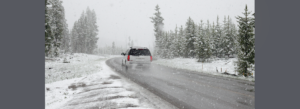Severe weather warnings for UK issued
Motorists are being advised to plan ahead and prepare in advance before setting off in icy weather. Yellow warnings have been issued for the south-west and north-east coast of England, including northern Scotland and Northern Ireland.
National Highways have deployed its fleet of gritter vehicles after the Met Office issued a series of severe weather warnings. Gritters are heading out this week for the first significant operation of this winter season on motorways and major A-roads, as temperatures fall below freezing across the country.
With October and November having mild weather, minimal action was needed, with road surface temperatures staying above +1 degrees Celsius until last week. An arctic maritime airmass is bringing in the cold weather to the UK, with risk of ice, wintry showers and snow.
This cold snap comes amid extensive rail strikes, meaning that more people may use cars for their commute. This cold snap is set to last until the weekend in most places in the UK, with a Level 3 Cold Weather Alert issued by the UK Health Security Agency (UKHSA) covering all of England until Friday 16 December. Further severe weather warnings could be issued.
Darren Clark, severe weather resilience manager at National Highways, states: “Not all roads will need treating on any given day.”
“Gritters may need to go out in some regions if road temperatures fall below +1 degrees C, and if there is a risk of ice forming, but not in other areas if conditions are not as cold.”“We are armed with the latest technology, forecasting intelligence and years of experience to help us make informed decisions about where and when we need to spread salt to help keep road users safe in even the most adverse weather conditions.”
The following are some tips on how to drive in snow and icy conditions:
Plan your journey
Make sure you know where you need to go before you set off on your journey. Consider areas that may be exposed to the elements or prone to flooding. Keep up to date with the local weather to ensure you aren’t caught out in the worst conditions.
Give yourself more time to travel
Allow more time than you normally would when travelling to ensure all your windows are clear, including mirrors, lights and the top of your roof before setting off. Driving with snow on your car could result in you breaking the law. It is also illegal to drive without full visibility through all your windows. These checks can be time consuming so it is worth factoring this in before you set off.
Check your tyres
Poor quality tyres will not grip when driving on snow and ice, so make sure to check your tyres for adequate tread.
Be prepared for the worst
Be prepared for every eventuality by making sure you have a small emergency pack ready in case you break down. This should include:
- a demister pad
- a hi-vis vest
- a blanket to keep you warm
- food and drink
- de-icer
- ice scraper
- torch (preferably a wind up torch)
- shovel
- phone charger
- map
- first aid kit
- jump leads
To drive in snow, you should wear comfortable and dry footwear. Accelerate gently, using low revs and change up to a higher gear as quickly as possible. Move off in second gear as this can help to reduce wheel slip.
Get your speed right and maintain a safe stopping distance between you and the car in front, leaving as much as 10 times the normal recommended gap. Use a low gear for going downhill and try to avoid breaking unless necessary.
If your car does lose grip, try not to panic. You should take your foot off the accelerator and make sure that your wheels are pointing in the direction you want to go in.
If you do encounter a skid, steer gently into it. Do not take your hands off the steering wheel or break harshly.
Useful Links
To find out more about our fuel cards click here – https://www.cambriancards.com/fuel-cards/
To learn how our telematics solutions will help your fleet become more efficient and effective, click here – https://www.cambriancards.com/telematics/
Read the following driving advice on the GOV.UK website: https://www.gov.uk/guidance/the-highway-code/driving-in-adverse-weather-conditions-226-to-237

